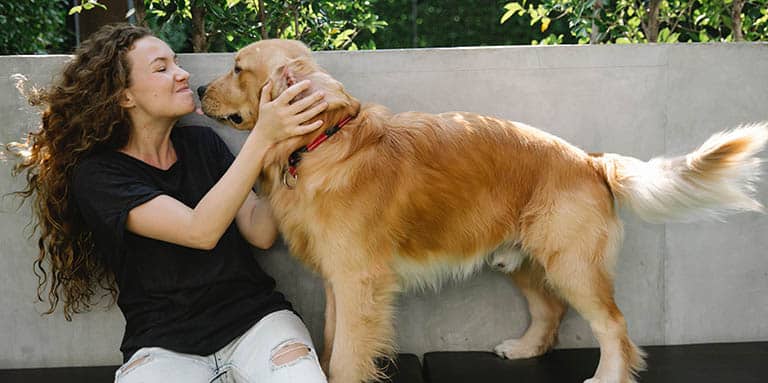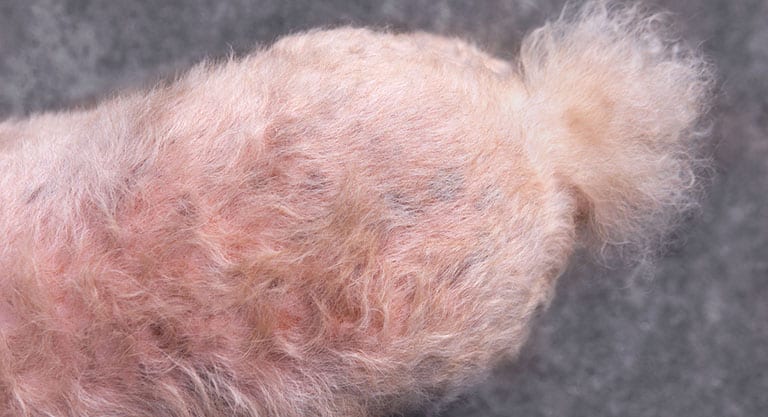Around 21% of dogs will experience a skin condition at some point in their lives. Discover in this blog effective treatment options for diverse skin problems, ranging from dry and dandruff-prone skin and hot spots to atopic dermatitis and yeast infections. Uncover root causes and symptoms of common canine skin issues to watch out for. These insights will help you maintain your furry friend’s skin health no matter the problem.
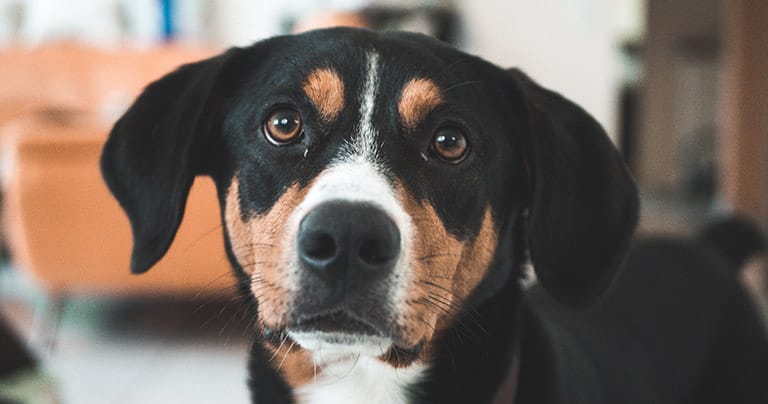
Dermatitis
Hot Spots
Hot spots, also known as summer sores or acute moist dermatitis, are common and manifest as red, oozing sores that are hot to the touch. Typically caused by a dog’s excessive chewing, licking or scratching, these sores can become painful and infected if bacteria is introduced. While hot spots can develop anywhere on a dog’s body, they are most commonly found on the neck, face and legs. If they are left untreated, these sores may lead to widespread infection and skin ulcers.
Hot spots are more common in humid summer climates or after your dog gets wet. Underlying issues such as allergies, parasites, poor nutrition and anal gland impaction can trigger scratching and licking. These actions can result in creating a moist environment that fosters bacterial growth.
If the hot spot is rapidly increasing in size, bleeding continuously or showing any colored discharge, then you need to take your dog to the vet as soon as possible. Treatment can include topical and/or oral medications, antiseptic spray, specialized shampoo or a mild water-based astringent for home use. It’s also recommended to clear the area from hair to allow for better airflow and place an E-collar or inflatable collar around your pet’s neck to prevent them from reaching the itchy spot. To learn more about hot spots on dogs read here.
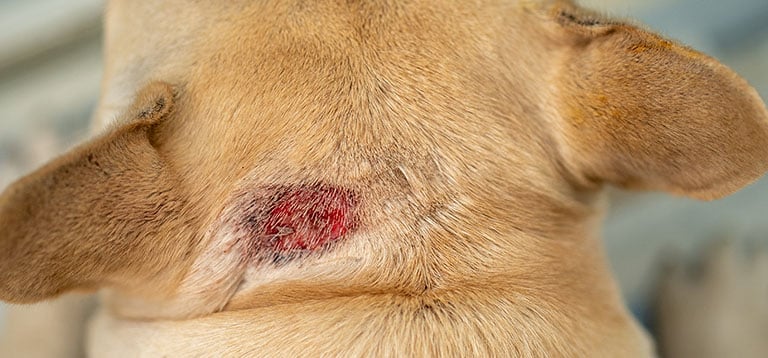
Atopic Dermatitis (atopy)
Atopic dermatitis (atopy) is a prevalent skin disease that affects around 10-15% of dogs. Different allergens including dust, pollens and molds can cause negative reactions in dogs. This can lead to symptoms such as redness, itching and toughness of skin. The canine may often display behaviors like chewing, scratching or licking resulting in hair loss and increased redness of the skin. Dogs can typically get this chronic infection around their feet, face, armpits and groin.
Treatment for this chronic condition can include hyposensitization therapy. The vet injects the pet with the allergens they are sensitive to and this causes a 60-80% reduction in the dog’s itchiness. Noticeable results typically appear after around six months. Another treatment option is immunomodulatory medications that can be taken in the form of a daily pill or injections every 4-10 weeks. Additionally, maintaining the pet’s skin health is crucial and should involve regular baths with prescription-strength dog shampoo recommended for this specific skin condition.
Yeast Infection
A yeast infection, or yeast dermatitis, is a fungal infection on a dog’s skin that arises from an overproduction of yeast. Factors that contribute to yeast overgrowth are immune system variations, allergies, poor diet, excessive heat exposure, inadequate hygiene and trapped moisture. Yeast infections typically show up on a dog’s paw pads, ears, or in their skin folds.
A dog experiencing a yeast infection may show signs of red, irritated and flaky skin. They may tilt and shake their head often because the infection is in their ear or aggressively chew on their paws. Bald patches and greasy skin are common symptoms along with smelling a musty odor or a scent reminiscent of Fritos.
Yeast dermatitis is treated with anti-fungal medications and/or medicated shampoos. In severe cases your veterinarian may recommend your pet take oral tablets like ketoconazole, fluconazole or terbinafine.
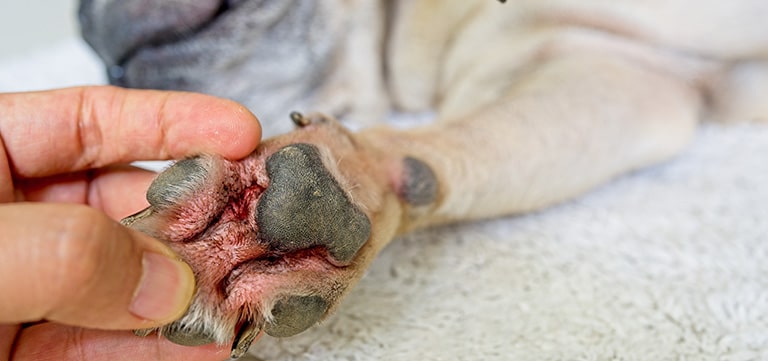
Skin Infections
Folliculitis
Inflammation of hair follicles caused by bacteria is called folliculitis. This condition can result from various factors such as underlying systemic diseases like Cushing’s disease or skin disorders like canine acne. Additionally, other causes can include parasitism, fungal infections and skin-fold pyoderma. The skin around the compromised hair follicles shows signs of reddish swelling, hyperpigmentation, hair loss and draining tracts. The dog may also experience pain around that area.
Successful treatment requires a three-pronged approach with a focus on topical therapy, systemic therapy and discovering the underlying causes for the skin condition. Your veterinarian may recommend using antimicrobial shampoo, giving your dog oral antibiotics and testing for different disorders and diseases to achieve the best treatment plan. The duration of treatment is anywhere between 3-12 weeks, depending on the severity of the folliculitis.
Ringworm
Ringworm, named for its characteristic round, red ring, thrives on the skin’s outer layer and in hair follicles. Typically, it only affects a few areas on the dog’s body. This highly contagious fungal infection is transmitted through direct contact with contaminated pets or humans.
Symptoms include circular hair loss, dry and brittle hair and rough, brittle claws. Once diagnosed by a veterinarian, topical treatments like ointments or medicated shampoos are recommended. This approach generally takes several months to completely heal. Alternatively, antifungal oral medications may be prescribed, taking a minimum of six weeks to completely get rid of the skin infection.
It is crucial to combine either of these treatment plans with environmental decontamination. Deep clean the items and places that your dog regularly comes in contact with such as couches, grooming tools, bedding, clothing and furniture. Wash the items in hot water and thoroughly vacuum to remove pet hair.
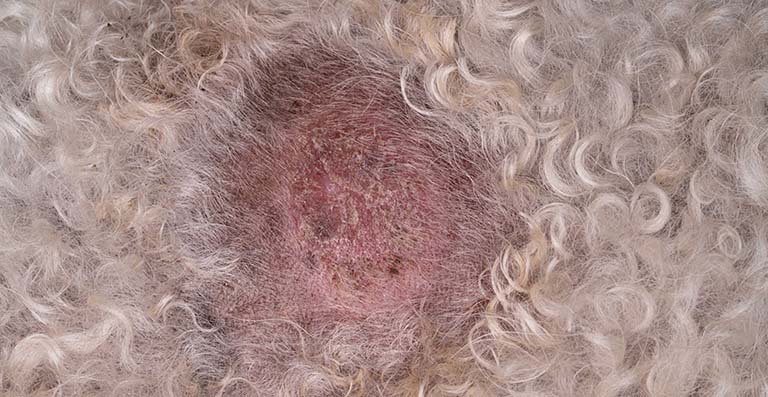
Dry Skin and Dandruff
Dry skin can be uncomfortable for your dog and, when accompanied by dandruff, can also impact their appearance. Factors such as nutritional deficiencies, dry air or weather conditions may be responsible for the flaking and dryness.
Addressing your dog’s nutritional needs is important. They may need an increase in their daily intake of omega-3 fatty acids, vitamin E or probiotics. Speak with your veterinarian about what your pet may be lacking and the right supplements they should take.
Apple cider vinegar can effectively control dandruff and soothe itching when applied directly to the skin with no rinsing required. Mix 50/50 with water and use moderation. Coconut oil can similarly be rubbed onto the skin, but using an excessive amount can result in a greasy appearance. Consider adding moisture to your home environment with a humidifier to alleviate dry air issues.
Consult your groomer for tailored skin treatments and shampoo options. Pet grooming salons like Smoochie Pooch offer skin repair therapies that are designed to work in partnership with veterinary care and diagnosis.
Your Dog’s Skin Health
Recognizing the symptoms of various skin conditions is pivotal for prompt and effective intervention. From hot spots to ringworm, each skin condition demands a tailored approach for treatment.
It is important to follow the recommendations of your veterinarian. Explore topical and oral solutions, as well as environmental considerations to ensure your dog receives the best possible care. Ensure your dog ingests a balanced, healthy diet, and seek professional advice from your groomer for holistic approaches to healthier dog skin. By staying proactive and informed, you empower yourself to address your dog’s potential issues early.
